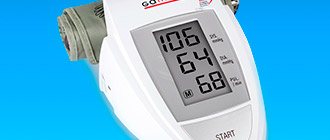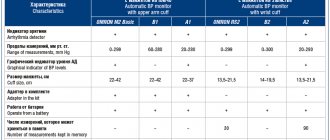Read in this article:
- Types of malfunctions of tonometers
- Mechanical damage and display problems
- Impaired cuff filling
- Error symbols on the device screen
- Cuff selection
- Replacing batteries and caring for the tonometer
- Violation of pressure measurement rules
- What to do if you have problems with the operation of the tonometer
An automatic tonometer is a simple and convenient device for determining blood pressure. With such a device, you do not need to listen to barely audible sounds through a phonendoscope, try to look at the numbers on the pressure gauge, and even inflate the cuff. The device itself performs all these functions and displays the measurement results on the display.
Types of malfunctions of tonometers
However, blood pressure monitors, like any other equipment, can experience malfunctions. Those who use such devices should understand what this or that error means and why it appears.
All malfunctions that occur in automatic tonometers can be divided into several groups:
- Mechanical failures;
- Problems with displaying indicators on the screen;
- Impaired air filling of the cuff;
- Displays inaccurate blood pressure readings.
If breakdowns occur, it is better to contact a service center. Trying to repair it yourself may make the situation worse, but in some cases you can deal with the problem yourself if you accurately understand its causes.
Mechanical damage and display problems
Mechanical faults occur as a result of damage to the device, for example, falling. If any element of the device is damaged, the only solution is to replace it with a new one. The cause of problems with displaying indicators on the screen is most often the detachment of the LCD display cable. In this case, individual segments of alphabetic or numeric symbols are not displayed. With such a malfunction you will have to contact a service center. The same applies to non-working buttons: repair involves disconnecting the electronic board and soldering in a new button.
Impaired cuff filling
Impaired air filling of the cuff can be expressed in different ways. For example, if the blood pressure monitor does not inflate the cuff or deflates quickly, the cause may be:
- Damage to the cuff - there is a special chamber inside it that can wear out or become damaged. In this case, it begins to deflate;
- Contamination or failure of the valve responsible for retaining air in the cuff;
- Broken tubes or connector at the cuff connection point.
When the tonometer does not pump air, most often the problem lies in the integrity of the parts. Finding the specific cause of a malfunction and eliminating it yourself is extremely difficult; it is better to entrust the solution to this issue to professionals.
The opposite situation is that the tonometer does not bleed air when measuring pressure. The first thing to do in such a situation is to check the connection of the air tube to the cuff on one side and to the device itself on the other. To avoid this situation, it is enough to check that the tube is in its place.
But it also happens that the tube is damaged for some reason. You should not try to replace it with a similar part; only original components that are intended for a specific model are installed in tonometers.
Is it harmful to measure blood pressure frequently? Is there a risk?
Many patients at a doctor's appointment are interested in whether it is harmful to frequently measure blood pressure with an electronic tonometer. And also how often it is better to do this. Experts say that frequent blood pressure measurements do not cause physical harm to a person, but can provoke a neurosis of obsessive blood pressure measurement. This mental disorder is difficult to cure, so it is not recommended to use the device unless necessary.
When asked about how many times to measure blood pressure with an electronic tonometer, experts have the following opinion:
- if you feel consistently good at home, blood pressure should be monitored no more than twice a day;
- Measurements should not be taken when the body is at its peak of activity.
If a person often measures his blood pressure with an electronic tonometer throughout the day, is this harmful? The question is rhetorical. This, first of all, indicates the presence of a psychological problem and can confuse not only the patient, but also the doctor.
Error symbols on the device screen
Device manufacturers have provided the ability to display errors in electronic tonometers on the screen. This allows the user to understand that the device is not working correctly, as well as find out the reason and take the necessary actions.
So, when measuring blood pressure with a Beurer BM 28 tonometer, errors may appear on the screen:
- E 1 indicates the impossibility of measuring pulse;
- E 2 indicates the impossibility of measuring pressure;
- E 3 appears when the cuff does not fit correctly - too loose or, conversely, too tight;
- E 4 indicates the occurrence of errors during the measurement process;
- E 5 is an error that appears when the inflation pressure is more than 300 mmHg;
- E 6 means a system error that requires contacting service.
Error symbols depend on the device model. Thus, on the screen of the Beurer BM 44 tonometer, the indication Er 1 will appear if it was not possible to measure systolic pressure, Er 1 - diastolic. If the readings are not within the intended measurement range, the Hi or Lo icons will appear. The device will indicate that the air has been inflated for too long or its excessive pressure, a malfunction of the system and incorrect position of the cuff. The designation of errors for each device is indicated in the instructions for it.
Daily blood pressure monitoring - who is prescribed and why, interpretation of results
What is it and how is it done?
Daily blood pressure monitoring is an instrumental study that monitors this indicator throughout the day. It is carried out like this: a cuff is placed on the patient’s shoulder to measure blood pressure. Using a special tube, the cuff is attached to the recorder. This small device pumps air into the cuff at regular intervals and then releases it. During the day, measurements are usually taken every 15 minutes, at night - after 30 minutes. A sensitive sensor determines the time of appearance and attenuation of pulse waves (as with conventional Korotkoff pressure measurement). The results are recorded in the device's memory. After reading them using a computer program, the functional diagnostics doctor analyzes the results and gives a conclusion.
What will this study show?
The study shows a number of important implications for human health.
- Maximum and minimum blood pressure (systolic and diastolic) during observation in the patient's natural environment, and not in the hospital.
- Average blood pressure during daytime and nighttime hours, which will determine whether the patient has hypertension. This is the main indicator for which the study is conducted.
- Circadian rhythm of blood pressure. Failure to lower blood pressure at night is associated with an increased risk of heart attack and stroke.
All this data will help make a diagnosis of hypertension and select the right treatment, and then evaluate its effectiveness.
About self-measurement of blood pressure
Constant self-measurement of blood pressure will provide much less valuable information. It cannot be carried out at night. If a person wakes up on purpose, this leads to an inevitable increase in pressure and distortion of the results.
You need to know that the most accurate results are obtained by measuring the traditional Korotkoff method (determination of tones using a phonendoscope). It is best to use semi-automatic devices with automatic air injection, since manual injection can cause a short-term increase in pressure. Devices that measure pressure on the wrist or finger are much less accurate. We recommend devices that operate on mains power rather than on batteries.
It should be taken into account that in approximately 5% of patients, pressure monitoring indicators differ significantly from self-monitoring data. Therefore, it is very important to carry out control measurements in the diagnostic room immediately after the start of the study.
How to prepare for research?
On the recommendation of the attending physician, certain medications for the treatment of hypertension may be discontinued before monitoring. If there are no special instructions, you must take all medications as usual. It is advisable to wear a light T-shirt with sleeves up to the elbow, and some loose clothing on top, since the recorder will be placed in a bag and hung around your neck, and there will be a cuff on your arm.
In some cases, it is recommended to bring batteries for the device. Alkaline (alkaline) batteries required.
Before the study, you can eat, drink, and lead a normal lifestyle.
How to behave during research?
Detailed instructions are given by the functional diagnostic nurse. She should give the patient a diary in which he will note his actions and sensations during each blood pressure measurement (except for sleep time), as well as taking medications and sleep time.
At the beginning of each measurement, the patient should stop and extend his arm down along the body, relaxing it. After completing the measurement, the subject must make an entry in the diary and continue the interrupted lesson. If the cuff slips, you need to carefully adjust it. The tube through which air is pumped must not be allowed to bend.
The increase in pressure in the cuff is often quite severe, resulting in pain when squeezing the arm. These feelings must be tolerated.
Indications for research
- “Borderline” blood pressure figures identified during repeated measurements using the Korotkov method.
- Monitoring of selected antihypertensive therapy, including to exclude episodes of severe hypotension after taking medications.
- Suspicion of “white coat hypertension”, when high blood pressure is recorded only when measured by medical staff. Suspicion of “workplace hypertension,” when increased blood pressure occurs at work.
- Severe hypertension resistant to treatment.
Who is recommended to undergo the study?
In the presence of the listed indications, especially valuable information can be obtained from the following groups of patients:
- Pregnant women.
- Patients with type 1 diabetes mellitus.
- “White coat hypertension” and “workplace hypertension.”
- Episodes of hypotension.
- Young people with disorders of the autonomic nervous system.
- Older patients.
- Patients suffering from hypertension without treatment effect.
Contraindications for the study
- Exacerbation of skin disease at the site of application of the cuff.
- Disturbances in the blood coagulation system with a tendency to bleeding during exacerbation.
- Injuries to both upper extremities, excluding the possibility of compression by a cuff.
- Impaired patency of the brachial arteries, confirmed instrumentally.
- Patient refusal.
- The study may be useless if there are significant disturbances in heart rhythm, as well as very high blood pressure values (more than 200 mm Hg).
What is Holter?
During the examination, a special portable device is used - Holter. Its electrodes are attached to the patient’s chest; they record all changes in blood pressure and record an ECG throughout the day.
The diagnostic device is named after Norman Holter, a famous American biophysicist researcher. In 1961, he developed a monitoring technique and put it into practice for the first time. Thanks to the Holter method, today cardiologists can identify disturbances in the functioning of the heart and various hidden diseases that are not visible on a regular electrocardiogram.
Why do you need daily ECG monitoring (Holter)?
Holter monitoring can be prescribed by a cardiologist or a general practitioner in order to confirm the diagnosis, check the effectiveness of treatment, discontinue medications, clarify details, etc.
The Holter method allows you to identify:
- Ischemic ECG changes.
- Heart rate.
- Type of heart rhythm.
- Heart rhythm disturbances: pauses, ventricular extrasystoles and others.
A regular cardiogram is significantly less informative than 24-hour monitoring, since although it can detect heart disease, it is not capable of assessing the frequency of its occurrence and the severity of its course. It is easier for the doctor to select adequate therapy after analyzing the Holter ECG results.
Who is recommended for 24-hour ECG monitoring (Holter)?
Typically, the electrodes of the device are installed in patients for a day; if nothing could be recorded within 24 hours and no deterioration occurred, then the monitoring is extended (maximum period of 7 days).
Indications for use:
- Coronary heart disease of various forms: silent myocardial ischemia, Prinzmetal angina, etc.
- Studies of heart rhythm disorders: Parkinson's, Wolff's, White's syndrome, atrial fibrillation, as well as ventricular tachycardia and sinoatrial block.
- Arterial hypertension.
- Heart defects.
- Treatment control
- Scheduled preventive examination.
In addition, daily ECG monitoring is prescribed if there are patient complaints of discomfort in the left side of the chest, a feeling of a sinking heart, fainting, or a feeling of lack of air. Diagnostics for frequent dizziness is also indicated.
There are no contraindications for diagnosis, except perhaps skin lesions in the chest area, which will complicate the procedure for attaching electrodes.
How is the examination carried out?
In the diagnostic room, special disposable electrodes in the amount of 5-7 pieces are fixed to the patient’s chest with an adhesive plaster (depending on the Holter model). Using a wire, the sensors are connected to a recording device. The device is in a special case and is hung on the patient’s neck or belt.
The specialist will provide instructions on how to use Holter and give the patient an observation diary. It must indicate all the events that occurred with the person being examined: deterioration and improvement of the condition, taking medications, physical activity, nighttime, as well as daytime rest. Data must be recorded with precise time reference.
To see how the cardiovascular system reacts to stress, during the study the doctor may advise the patient to walk up the stairs. This will help find a connection between complaints and changes in the electrocardiogram.
Important! If the patient experiences any interruptions in the heart’s function within 24 hours, the rhythm increases for no reason, dizziness or other complaints appear, this must be recorded in the diary.
During diagnosis, you cannot undergo magnetic resonance imaging and x-rays of organs. A day later, the doctor removes the electrodes and deciphers the data obtained.
Monitoring - indications, installation, results, harm
Holter monitoring is a method of functional diagnostics that allows for daily monitoring of the electrocardiogram. ECG recording is carried out continuously from 24 hours to three days. To monitor the ECG, a Holter is used - a small portable recorder that records the round-the-clock work of the heart and records data on its work over the course of a day on a computer. These records are subsequently deciphered by a cardiologist.
Holter monitoring was named after researcher Norman J. Holter, who first put this device into practice in 1961.
When installing a Holter monitor, electrodes are attached to the patient's chest. The electrodes, in turn, are connected to a recording device. Of course, the patient experiences certain inconvenience while wearing the device, however, the study itself is very informative and accurate, which allows the cardiologist to determine an accurate diagnosis.
The data processing program provides analysis and determination of all types of heart disorders, in particular attacks of angina pectoris and arrhythmia, which can significantly improve the effectiveness of treatment of cardiovascular diseases.
Who is Holter monitoring indicated for?
With the help of a Holter, an ECG is prescribed primarily to determine heart rhythm disturbances - episodes of atrial fibrillation, extrasystoles, etc., which are quite difficult to detect during a short study - a regular electrocardiogram.
It happens that some atypical contractions for a healthy heart muscle appear only during periods of active physical activity, severe emotional shock, or in other situations. In these cases, such disturbances cannot be detected using a conventional electrocardiogram, whereas with Holter monitoring the patient can lead his usual lifestyle: engage in a certain sport, work, take any body position, etc.
Also, using a Holter study, you can determine various disorders of the blood supply to the heart muscle, in particular changes in the ST segment during sports or physical activity.
Can a Holter study negatively affect a patient's health?
Holter ECG does not pose any harm to health. There is also no risk of electric shock.
To avoid damage to the device, it is recommended not to take a bath or swim while wearing it to prevent water from getting inside. It is also not recommended to go through a metal detector while wearing a halter.
How is a Holter monitor installed?
Before the device is attached to the patient's body, he is advised to take a shower, since he will not be able to take a bath or remove the monitor for the next day or more.
The doctor attaches the electrodes to the patient’s chest and adjusts their position. Subsequently, the doctor connects the electrodes to the wiring of the recording device, which is attached to the patient’s body using special belts.
The doctor instructs the patient and teaches him to keep a diary. This is necessary for correct decryption of data received from the device. The patient records periods of sleep, wakefulness, physical activity, rest and all symptoms (chest pain, tachycardia, arrhythmia, etc.) with an exact indication of time.
After installing the device and receiving a list of instructions, the patient can return to his usual rhythm of life and daily routine.
Holter monitoring is an absolutely painless procedure. The patient experiences slight inconvenience only when wearing the device, when the wires and box of the device are hidden under clothing. During sleep, it is not recommended for the patient to turn over on his stomach, as the electrodes may become dislodged, which will disrupt data recording.
Holter study results
The holter is removed directly by a cardiologist or nurse. The patient provides the physician with a diary of activity and symptoms, which the physician examines along with device data.
Depending on the situation, the doctor makes a final diagnosis or sends the patient for additional examination. If the results of a Holter study within a day do not allow the doctor to form a definite picture, he can prescribe the patient to temporarily wear a heart rate recording device, which the patient himself will activate during the onset of alarming symptoms.
Why is ABPM necessary?
Blood pressure is an extremely unstable indicator. It can change during the day, depend on the emotional state, and differ during sleep and wakefulness.
It is worth mentioning the term "EBH", the white coat effect, the essence of which is that some patients experience undue anxiety simply because they are in the doctor's office.
Their blood pressure rises, which does not correspond to the true blood pressure level. A lot of negative factors can influence measurement deviations: a cold stethoscope, crossed legs, excitement. To prescribe the “correct” doses of antihypertensive drugs, it is extremely important to know the exact blood pressure standards obtained in the patient’s usual environment outside the doctor’s office.
An objective picture is provided by 24-hour blood pressure monitoring (ABPM) using a fully automated device mounted on the patient’s arm. The device records blood pressure values for 1-2 days under normal human conditions.
By analyzing the data obtained, the doctor confirms or denies the presence of hypertension. ABPM has a number of advantages over traditional studies.
The following disadvantages inherent in clinical measurements are excluded:
- the influence of an alarming reaction, which entails overdiagnosis of blood pressure and incorrect medical therapy for patients with EHD;
- rounding the measurement result, usually to tens;
- subjective assessment, when the researcher (doctor) is pre-set on a certain result, which he believes the patient “should have”;
- inability to take into account blood pressure fluctuations within 24 hours.
Daily monitoring is also useful for patients with already diagnosed arterial hypertension, when the study is combined with taking medications
Indications for use
The ABPM technique is indicated for:
- ineffectiveness of antihypertensive treatment;
- high blood pressure numbers in patients without signs of target organ damage (kidneys, myocardium, fundus, brain) and without identified risk factors for arterial hypertension (AH);
- normal blood pressure in patients with established risk factors for hypertension or existing target organ damage;
- high variability of blood pressure during self-measurement or during repeated visits to the doctor;
- frequent episodes of hypotension (low blood pressure) in older patients with type 1 diabetes;
- suspected preeclampsia.
ABPM is used in clinical practice not only in patients with hypertension, but also in patients with cardiac arrhythmias.
Preparatory activities
The first step is to make an appointment with a cardiologist. At the Family Doctor Children's Center for ABPM, you can undergo an examination without a doctor's prescription, but it is better to stock up on a referral, since a specialist must evaluate the results of the examination.
ABPM requires a free machine, so pre-registration is required.
In our center you are accepted without a queue and by appointment, but in public medical institutions you will have to wait several weeks. No special preparation is needed. The device will be installed by a doctor. He will select the “correct” cuff depending on the circumference of the patient’s shoulder.
A cuff that is too short or, conversely, long will distort the readings. The bag with the monitor (reading mechanism) is attached to the patient’s belt. The cuff is placed on the non-working arm: for right-handers - on the left, for left-handers - on the right.
The doctor will check the device for accuracy by alternately measuring blood pressure on one arm with a monitor and on the other with a regular tonometer. If the numbers match, the patient is sent home.
From this moment on, the device will periodically measure your pressure and “remember” the data. ABPM allows you to obtain fairly accurate daily blood pressure dynamics, provided that the patient adheres to the doctor’s recommendations.
The result will be distorted if the patient does not inform the doctor about the medications currently taken.
Who is contraindicated for 24-hour blood pressure monitoring?
ABPM is a non-invasive technique that does not require serious intervention in the body. However, there are a number of contraindications for it.
Diagnosis is not possible if:
- upper limb injury;
- skin diseases localized in the arms and shoulders;
- rigidity of the vascular system, since the accuracy of the test is impaired;
- pregnancy;
- heart disease and other serious pathologies that interfere with diagnostics;
- high blood pressure levels;
- blood clotting disorders.
In these cases, the diagnosis of ABPM will have to be abandoned, turning to traditional blood pressure measurement.
How is it going?
Diagnostics are carried out for a day or two. The first 2 hours are not taken into account as this is the adaptation time. Your doctor will ask you to keep a diary to record your hours of exercise and periods of rest, times you sleep and wake up, medications you take, heart pain, and other symptoms of discomfort if they occur.
Blood pressure registration occurs once every half hour during the daytime and every hour at night, at least. At the appointed time, the patient comes to the clinic and the device is removed from him. The doctor processes the device readings. The results obtained are interpreted by a cardiologist, comparing them with entries in the diary.
During the examination, the patient should follow simple recommendations:
- monitor the position of the cuff. If it has slipped, correct it;
- at the moment of start, the device emits a sound signal and begins to pump air into the cuff. Try to relax your hand at this time. If possible, do not move, so the readings will be more accurate. At the end of the measurement, a repeat beep will sound;
- do not pinch the tubes connecting the monitor to the cuff;
- stay away from electromagnetic devices;
- Avoid stressful situations. Anxious reactions greatly distort the readings of the device;
- temporarily refrain from swimming;
- don't drink alcohol;
- Protect the device from moisture. If there is an urgent need to remove the cuff, carefully disconnect the tubes from the monitor. Otherwise, when air is pumped, they may burst;
- if you notice that the device has stopped working, inform your doctor;
- stop taking antihypertensive medications (with the consent of your doctor);
- don't forget to keep a diary.
The ABPM technique does not prevent the patient from living his normal life, although it does introduce minor discomfort.
The accuracy of the readings largely depends on the patient's behavior during diagnosis. Listen carefully to the doctor’s instructions before conducting the test and try to follow all recommendations.
Decoding the results
During the study, it was possible to obtain 14 reliable measurements during the daytime and at least 7 during the night. Based on them, the doctor calculates the average blood pressure and pulse rate.
Since the interpretation of average values today does not pose a problem and is carried out on the basis of generally accepted standards, the most important are the “additional” ABPM readings:
- circadian rhythm (CR). ABPM is the only non-invasive study that provides a complete picture of this characteristic. The main indicator of SR is the percentage decrease in blood pressure at night. Violation of this value signals dysfunction of the cardiovascular system (CVS) and damage to target organs by hypertension. A practical problem in using the indicator is its low reproducibility, therefore, to confirm the reliability of identified SR failures, repeated monitoring is required, which is not always convenient for the subject. However, this characteristic must be taken into account in the conclusion based on ABPM results, especially if the procedure is performed for diagnostic purposes;
- ambulatory pulse blood pressure. This indicator is directly related to myocardial and vascular problems. ABPM assesses this characteristic more accurately than clinical studies. The “critical” value of ambulatory pulse pressure is 53 mmHg. Higher values indicate a risk of CV complications;
- blood pressure variability. Elevated values of this indicator may indicate incorrect antihypertensive therapy and the need to change the treatment regimen;
- morning dynamics of blood pressure. It is known that at this time the greatest number of heart attacks, malignant arrhythmias and strokes occur, which can cause sudden death of the patient. The morning increase in blood pressure in hypertensive patients is consistently higher than in healthy people, which is fraught with cardiovascular complications;
- assessment of hypotension episodes in the daily blood pressure profile. For an objective quantitative assessment, it is sufficient to take into account only the minimum blood pressure values;
- smoothing index (SI). Since ABPM provides a large amount of information, it can be used to more accurately assess the effectiveness of antihypertensive drugs. The indicator is calculated based on the hourly effects of the drug: the ratio of the average effect to the deviation from it. An IP of at least 1.2-1.5 is considered optimal.
The listed additional indicators of ABPM are very important. However, their practical use is still limited. The situation should change with the introduction of new generation drugs for hypertension into clinical practice and the widespread use of chronotherapy methods.
Cuff selection
The accuracy of blood pressure measurements depends on the correct position of the cuff and its appropriate size for the arm. Before choosing a device, you need to find out how to determine the size of the tonometer cuff. To do this, you need to measure the circumference of your arm in the middle between the elbow and shoulder. If the number is less than 22 cm, you need a small cuff, and if it is more than 32 cm, you need a large one.
Beurer tonometers are equipped with three types of cuffs:
- Small – for shoulder coverage 22-30 cm;
- Medium or universal – 22-42 cm;
- Large – 30-42cm.
It is worth purchasing a device with a universal cuff to measure blood pressure for several family members with different shoulder coverage. If the size of the cuff does not fit the dimensions of your arm or the device is faulty, you can buy a new cuff for a specific tonometer model.
Interval between procedures
The question of how often you can measure blood pressure with an electronic tonometer is very relevant. Medical professionals unanimously believe that the frequency of monitoring depends on certain factors. People in excellent shape can take measurements from time to time, but those who suffer from cardiac diseases should approach the procedure responsibly and monitor their blood pressure more often. In old age, frequent measurements are contraindicated. This is due to the extreme fragility of blood vessels. To determine how often you can measure your blood pressure with an electronic tonometer, you need to evaluate the following factors:
- general well-being of a person;
- age;
- presence of concomitant diseases;
- features of previously suffered diseases;
- a type of tonometer.
All people, without exception, should monitor their blood pressure, only the frequency of measurements in each case may differ significantly. For example, it is enough for a healthy person to take measurements once every few months. And for those who suffer from cardiac ailments, blood pressure should be measured daily.
Replacing batteries and caring for the tonometer
Often problems with measuring pressure arise due to discharged batteries. Before using the device, you should check the batteries and replace them if necessary. Many blood pressure monitors indicate on the screen that the batteries are low using a special icon. The same applies to models with a battery that needs to be recharged in a timely manner.
If the indicator indicates low batteries, you must reset the result, turn off the device and replace the batteries. Only then should the measurements be repeated.
Another cause of malfunctions is improper care of the device and violation of the rules for storing it. The tonometer needs to be cleaned from time to time using a slightly moistened cloth. Do not treat the device with cleaning agents or solvents.
Neither the device nor the cuff should be immersed in water, as this will cause damage. You should also not place heavy objects on them, and strong bends in the hoses are not allowed. Before long-term storage, remove the batteries. Do not store the device near a heat source, for example, near a battery.
How to take measurements correctly?
To ensure correct blood pressure measurements, you must not violate the following recommendations:
- Before the examination, if possible, you should rest and sit calmly for five minutes. If emergency assistance is required, this item can be neglected.
- Indicators may be overestimated if a person drank coffee or smoked during the last two hours before the study. You should give up bad habits for a short time, as the readings may be incorrect.
- To measure blood pressure, a person must be seated in a chair with a backrest. The back should be relaxed, legs lowered, not crossed or tense. Any violation can lead to serious errors, especially in the case of an electronic tonometer.
- The shoulder must be freed from clothing. It is necessary that she does not squeeze him.
- The hand must be placed on a table or stand so that it is closed at the elbow and at the same time completely relaxed.
- You need to check the electronic tonometer to ensure that there is no damage, kinks or kinks in the hose.
- The cuff should be unfastened and placed on the shoulder 2 centimeters above the elbow.
- You need to turn on the device using the button and wait for the automatic pumping and pumping of air. At this time nothing can be done.
- Wait until the numbers appear on the display and evaluate the results, then turn off the device and remove the cuff.
Violation of pressure measurement rules
Erroneous results when measuring pressure may not be due to a breakdown of the device, but to a violation of the rules of the procedure. This happens if:
- Take measurements several times in a row without a break (you need to wait 7-10 minutes, and only then measure the pressure again);
- Take measurements immediately after a meal or physical activity, after a cup of coffee or in a state of strong excitement;
- Talk and move, sit cross-legged, strain the arm on which the measurement is being taken;
- Wear the cuff over clothing;
- Incorrect placement of the tube (it should go through the middle of the arm);
- Take an incorrect position, for example, without back support, with your hand above or below heart level, while standing;
- Use the wrong cuff size.
The results can be affected by medications, energy drinks, alcoholic drinks, and even a full bladder.
How many times in a row can you take measurements? Doctors' advice
Doctors have a definite opinion about how many times in a row to measure blood pressure with an electronic tonometer. Experts recommend measuring blood pressure three times in a row while sitting or standing, at intervals of several minutes. Before re-measuring, it is necessary to flex and extend the limbs to restore blood flow.
In most cases, the first measurement is characterized by overestimated parameters. This occurs as a result of the fact that when the vessels are compressed by the cuff, an increase in the tone of the blood fluid occurs at a reflex level. Average indicators are considered the most optimal and correct.









